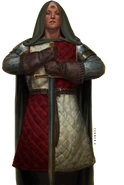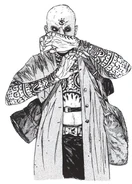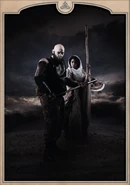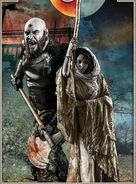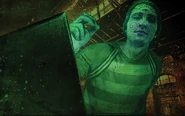The Salubri are one of the original 13 clans of the vampiric descendants of Caine.
Overview[]
In the Final Nights, the once mighty Salubri Clan is considered barely a bloodline after the diablerie of their progenitor, Saulot. Their general few numbers grant credibility to the rumors that they are only composed of seven vampires at any time, and that these modern Salubri are fully committed to the search for Golconda – enacting a bloody ritual when they achieve that state or despair of ever doing so. They are divided into three branches: the Healers, the Warriors and the Watchers, and each of those branches has their own specific vampiric weakness.
History[]
The Salubri are the childer of Saulot, most beloved of Caine and the healer of the Kindred. Saulot was a mystic uncomfortable with his awakened Beast and constantly questing to squelch it. In the interests of furthering this quest, and to tame the pains of the living and dead, Saulot Embraced the wise and the gentle to tend the pains of Caine and Seth's get. These childer, the Salubri, were revered as healers and peacemakers, unusually selfless for creatures more often defined by their greed.
Sometime in the era of the Second City, Saulot despaired of conquering his beast and fled to the unknown East to study under Hindu gurus and the Great Arhat Xue (under the moniker Zao-lat, leaving a rather unflattering mark in the collective memory of Xue's conspecifics). When he returned, he bore a third eye and new insight into the vampiric condition; his beast was quieted and he described his new condition as being in Golconda, named for the town where he finally achieved inner peace. The clan, revitalized by their ancestor's return, embraced the new discipline of Valeren (Healer Path) and enhanced their abilities. It was at this time, with the adoption of Valeren, that the third eye became the mark of all Salubri, originally a sign of enlightenment, it eventually became a target.
Saulot's return was a joyous occasion, but what followed behind him was not – a hitherto unknown line of vampiric demon worshippers, the Baali, attacked the Second City. Saulot, normally relatively sedate, viewed the Baali as an abomination and encouraged active retaliation. To that end, one of his childer, named Samiel, discarded the path of healing and took up the sword. Samiel was the founder of a new caste of Salubri, an order of warriors wielding the new path of Valeren (warrior Path), dedicated to overthrowing Baali and other forces of darkness.
Dark Ages[]
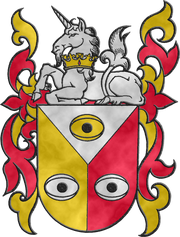
Clan Salubri c. 1197
The Salubri were always rare. Saulot himself entered Torpor sometime around the 1st century and only rarely resurfaced. Each caste was focused on its own particular purpose – hunting down demons or teaching Golconda, and given that the Salubri on the whole were not fond of being vampires, they did not embrace many childer. Those that were were usually exceptional in some fashion.
All of this changed in 1133, when the mage Tremere found and diablerized Saulot. The act, unheard of, was a desperate attempt by the new clan Tremere to acquire legitimacy by acquiring an Antediluvian of their own, but it nearly backfired. The Tremere, by committing the ultimate crime on the closest thing the damned had to a saint, only cemented their reputation as usurpers. The Tremere responded with a vicious propaganda campaign and cheap magic - the Salubri were never entirely trusted anyway, the price of being too nice. And now with the Tremere offering real magical power and less pangs of conscience, certain clans were too willing to believe that maybe that whole soul-sucking thing was a bit more true than they originally thought.
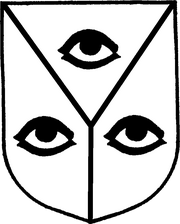
The Salubri c. 1230, stripped of their clan status
In less than a century, the Salubri were no longer the rare and precious Unicorns, but now feared soul-devouring horrors. An amazing feat, the Tremere campaign, as if another hand was behind it.
The Tremere coupled propaganda with terror; Tremere himself went into torpor shortly after draining Saulot, and the Council of Seven needed to boost their own power, preferably by diablerizing Salubri methuselahs. A conclave of the Clan in 1291 in Acre was held, during which the Salubri debated on how to react to the situation. The Healers renounced violence as contrary to Saulot's teachings, while the Warriors, disagreeing with them, split and instead waged one-man wars against their numerous enemies that more often than not led to nothing but their own destruction. This continued throughout the 12th century, ending with the capture and diablerie of Mokur by Etrius. Mokur's death meant the death of the last of the Salubri elders, and the clan slowly withered on the vine.
Victorian Age[]
During these times the clan was thought to be dead and gone, but at the end of the period their numbers seemed to be increasing due to the fact that some of the Salubri became antitribu and joined the Sabbat in order to destroy the Baali and the Tremere to get revenge for their acts against the clan.
The remaining pure Salubri found that the spirit of the age allowed them to find allies among the Kine, who searched for spiritual answers and were willing to overlook their peculiarities. The development of new technologies, such as the telegraph, also allowed the remaining Salubri to coordinate their unlives in more efficient ways, exchanging knowledge and informing them about new developments.
Modern Nights[]
In the twentieth century, the Salubri have all but died out, with only seven rumoured to be active (as well as a few hidden ones, such as Mahtiel), though this rumour is also believed by some to have been started by the Salubri themselves (in order to hide their true numbers, whether they be lower or higher than the rumoured seven). The main clan is now exceeded by bloodlines, including the Nkulu Zao of Africa and the Wu Zao of Asia. The Salubri, if they are known at all, are reviled for their strange and frightening soul-devouring powers.
And then something even stranger and more frightening happens, Salubri antitribu; the Sabbat accepts into its ranks the childer of Adonai. These warriors are consumed by the need for vengeance, and are creatures of rage, dubbed Furies by their Sabbat compatriots. They are not honorable creatures, but rather bitter knights driven to destroy the Tremere and seeking vengeance for their founder's destruction.
The lot of Clan Salubri has changed little in the last century. Even among sympathetic Anarchs distanced from the Ivory Tower and the Pyramid, those who know anything about them want little to do with them. Still, many remain motivated to act as guardians and healers who would come to the aid of Kindred struggling with or reveling in the vampiric condition.
Organization[]
The Salubri do not have much of an organization in the Final Nights. There are not enough of them for them to have one. When Salubri do meet, it tends to be on the instruction of their sires – the dying wish of a given Cyclops to her childe might be to seek out another member of the bloodline and deliver a message or pay respects.
Things were different before Saulot's death. At that time, the Healers had a loose community of equals, largely distinguished by progress on the path to Golconda. The Warriors, however, were distinguished by a ritual called the Blooding; it was in this ritual that a warrior was truly consecrated and took an angelic name to indicate their purpose and path. The Blooding also granted special powers; however, with the effective extermination of the warrior caste, the Code of Samiel was lost, and the antitribu of the modern age show no knowledge of it.
Culture[]
Again, there are not enough of them to have a culture. What little there is has mostly focused around Golconda lore. Salubri believe that vampiric existence is torment from which Golconda or death is the only escape. Consequently, the modern Salubri would Embrace, teach a childe the basics of the route, leave clues for the childe to follow to achieve Golconda, and then have their childe diablerize them. One side effect of this is that Salubri are all relatively low generation. Normal Salubri start out as 8th generation by default. Even the antitribu usually have a couple of dots in the background.
Embraces[]
Salubri generally Embrace noble souls; healers, teachers, empaths, and other good people that they feel can find Golconda. Beyond that, there is not much commonality. However, on occasion a Salubri might embrace an evil person in hope of seeing them redeemed (or at least setting them on a path to redemption). Each childe of a Salubri was seen as the culmination of their unlife, so they tended to observe their targets carefully and generally only Embraced when the person was willing to endure unlife.
Clan Variants[]
Saulot was a famously prodigious sire, creating the Salubri, the Wu Zao (who have two castes), and the Nkulu Zao. However, within the clan itself, the major distinction is between the Healer, Warrior, and Watcher castes.
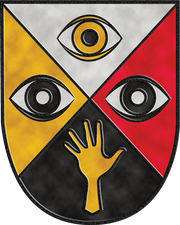
Healer Caste c. 1242
Classically, the Salubri discipline was called Valeren and was divided into three paths: Healer, Warrior and Watcher. All paths developed the third eye after learning the second level of the discipline (and any vampire who learns Valeren acquires a third eye). The three paths of Valeren mirror each other, with powers at equivalent levels having similar effects. In modern nights, the Healer path has become its own Discipline, Obeah.
Modern references to the Salubri typically refer exclusively to the Healer Caste, who make up the bulk of the "normal" Bloodline.
Warrior Caste[]
The Warrior Salubri were founded during the Baali Wars by Saulot's childe Samiel. Samiel renamed himself after an angel of the Lord, in a secret ceremony that is called the Blooding. Since then, every Salubri Warrior was expected to undergo the same ritual and be granted an angelic name.
All warriors undergo rigorous training to prepare them for the Blooding, sometimes even when they are still mortal. The Warriors were wanderers, always searching for evil to destroy wherever it might grow. This brought them into conflict with various Clans and their unsavory members and when the Tremere began their pogrom, the Warriors had nowhere to turn to and were unsure how to proceed. Many Warriors died in battles against forces they deemed evil.
In the Final Nights, the Salubri antitribu appear to be resurfaced Salubri Warriors.
Watcher Caste[]
The Wu Zao, or the Watcher Caste in the Dark Ages, are an Asian bloodline of Salubri who came about during Saulot's travels to the East, where he was known as Zao-lat. He chose two individuals to Embrace: Zao-zei, a thief capable of obtaining the secrets of the Thousand Hells, and Zao-xue, a scholar who could decipher those secrets. The three adventured around the Middle Kingdom, plundering the lairs of the akuma and stealing their plans.
The Wu Zao are, perhaps uniquely among Cainites, capable of switching between their castes of scholars and thieves. During the Dark Ages, The Watchers acted as protectors of the Cainites, protecting them against those that would deny their right to even exist and earn redemption, like Lupines or the Wan Kuei. Additionally, they sought for knowledge that will allow Cainites survive the cataclysmic turns of the Wheel of Ages. Only rarely did they traveled into the West, seeing it as more important to preserve Zao-lat's wisdom than his descendants. Contact was only established during the invasion of the Golden Horde, during which the Watchers often masqueraded as members of other Clans or Castes.
Interestingly, the Wu Zao do not share the clan weakness of other Salubri. This is because Saulot's order that Zao-xue and Zao-zei gather secret knowledge permeates the blood of every Wu Zao. Thus, each Wu Zao must choose an area of arcane lore that becomes the focus of her unlife. A Willpower roll is required to resist pursuing an opportunity to research this subject – regardless of how dangerous this opportunity is.
Salubri antitribu[]
The Salubri antitribu of the Sabbat are not the quiet, contemplative Kindred that seek Golconda in persecuted exile. No, these Kindred call themselves "Furies", and they seek the blood of the Camarilla vampires – the Tremere especially – with a venomous passion. They are the modern incarnation of the ancient Warrior Caste. A Sabbat pack is said to have discovered a torpid Adonai and the last Salubri Warriors in a mine outside Prague during the 1990s. Who upon their awakening gave rise to these antitribu. [2]
The Salubri antitribu are devoted to the cause of killing Camarilla vampires, but not necessarily to other Sabbat agendas.
They take part in the ritae of the sect, and they share their blood, but what truly fires them up is the chance to invade Camarilla territory and burn some Tremere. If the ancient rumors of the Salubri warriors being honorable knights are true, then times have indeed changed. These Kindred do not know "honorable combat" from "IED". They just want to watch their enemies crumble to dust.
It is possible that these are the remnants of the "two of Aariel's line" and their followers who renounced their names and took Infernal ones following the diablerie of Saulot, as "Adonai" would suggest.
The Furies clan weakness is slightly different from that of the main Salubri; they receive nourishment from blood taken either by force or during a Frenzy.
Al-Amin[]
Islamic Salubri, known as al-Amin (literally "The Virtuous Ones"), were no less lucky than their European counterparts. For centuries, they kept watch on the Baali from North Africa to Asia, usually disguising themselves as members of other clans. When Saulot was diablerized, the Assamites, who were al-Amin allies, worked to smuggle as many Salubri out of the reach of the Tremere as possible. How successful this effort was is debatable, as many were killed anyway helping others or in fights with the Baali.
The Ashirra have protected seven al-Amin from destruction into the Final Nights thanks to an accord between the Old Man of the Mountain and the Salubri methuselah Nahum ben Enosh. They are protected as long as they live in Ashirra territory and their numbers never surpass seven. The seven are treated as royalty, but are always watched, something that has begun to grate on the younger generation that want more freedoms.
Weaknesses[]
Classic[]
Modern Salubri are unable to feed on an unwilling vessel without dire complications, such as losing one Health Level per Blood Point slaked, which must be healed with blood (in addition to the compulsion of seeking Golconda) (Second Edition); or losing one point of Willpower (V20).
Fifth Edition[]
Bane[]
Hunted: A Salubri's Bane is that the Kindred of other clans are especially appreciative of Salubri vitae. When a non-Salubri partakes of the blood of a Cyclops, they often find it difficult to pull themselves away. Consuming enough to abate at least one Hunger level requires a Hunger Frenzy test. If the test fails, they just keep consuming, to the point that they may have to be physically fought off. Additionally, the third eye that Saulot opened while on one of his many journeys passes down through the bloodline every time a Salubri Embraces. This third eye is not always recognizably human in origin, and rumors persist of vertical, serpentine pupils, or even wormlike eyespots. While this third eye can be physically covered, such as with a headscarf or hood, it is always present, and no supernatural power can obscure it. Any time a Salubri activates a Discipline power, the third eye weeps vitae, its intensity correlating to the level of the Discipline being used, from welling up to a torrential flow. The blood flow from the third eye triggers a Hunger Frenzy test from nearby vampires with Hunger 4 or more.
Compulsion[]
Affective Empathy: When a Salubri suffers a Compulsion, the Kindred becomes overwhelmed with empathy for a personal problem that afflicts someone in the scene, seeking to further its resolution. The scale of the personal problem isn’t important; the Salubri understands that sometimes suffering is part of a cumulative situation and not an isolated stimulus. Any action not taken toward mitigating that personal tragedy incurs a two dice penalty. The Compulsion persists until the sufferer’s burden is eased or a more immediate crisis supersedes it, or the end of the scene.
Version Differences[]
The Salubri have gone through a variety of changes. The original Salubri were the tiny bloodline mentioned above, while Vampire: The Dark Ages introduced the concept of a Warrior caste, as well as the Valeren discipline. The antitribu first appear in Vampire: The Masquerade Revised Edition.
The general implication of Salubri history is that Saulot has played them for fools – he seems to constantly tweak the clan for his own purposes, and the campaign of diablerie and defamation seems to have been orchestrated by Saulot as part of his own schemes. This is generally tied in with revisions to both Saulot and the concept of Golconda.
In Vampire: The Dark Ages 20th Anniversary Edition the clan divided into three castes: Healers, Warriors, and Watchers.
Trivia[]
- The classic Salubri font is Lithograph.
Gallery[]
References[]
- VTM: The Players Guide, p. 131-135


- VTDA: Vampire: The Dark Ages

- VTDA: Clanbook: Salubri

- VTM: Lore of the Bloodlines


- VTDA: Vampire: The Dark Ages 20th Anniversary Edition


- VTM: Vampire: The Masquerade Companion, p. 13-15
| Vampire: The Masquerade Clans |
|---|
| Banu Haqim (Assamites) · Brujah · Gangrel · Hecata (Cappadocians, Giovanni) · Lasombra · Malkavian · Ministry (Followers of Set) · Nosferatu · Ravnos · Salubri · Toreador · Tremere · Tzimisce · Ventrue |







